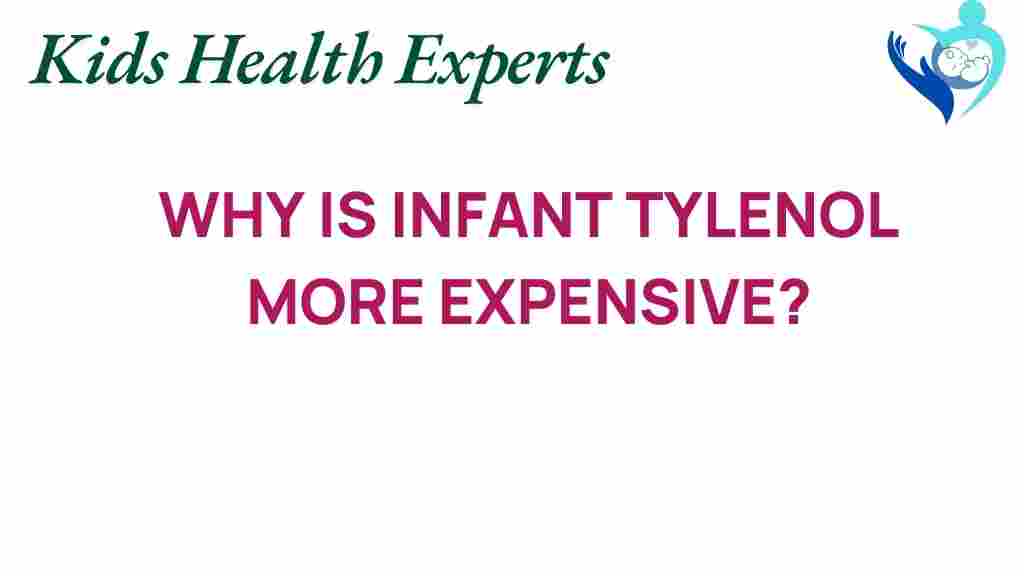The Hidden Costs Behind Infant Tylenol: Why Price Matters
When it comes to caring for infants, parents often face a multitude of decisions, especially surrounding health and wellness. One frequently used medication in infant care is Infant Tylenol, which is known for its effectiveness in relieving pain and reducing fever. However, while the benefits of this medication are well-documented, the hidden costs associated with it—ranging from medication pricing to broader healthcare expenses—are often overlooked. This article aims to explore the various dimensions of these costs and highlight the importance of consumer awareness in a complex pharmaceutical landscape.
Understanding Infant Tylenol and Its Role in Infant Care
Infant Tylenol, containing acetaminophen, is a common over-the-counter medication used to alleviate discomfort in infants. Parents typically administer it for:
- Fever reduction
- Pain relief from teething or vaccinations
- General discomfort due to colds or flu
While effective, the pricing of Infant Tylenol can vary significantly based on various factors, including brand, formulation, and retail outlet. Understanding these factors is essential for parents who want to manage their healthcare expenses efficiently.
The Complexities of Medication Pricing
The cost of Infant Tylenol is not solely determined by its manufacturing price. Several elements contribute to the final retail price that consumers pay:
- Manufacturing Costs: The expenses incurred during the production of the medication, including raw materials, labor, and overhead.
- Marketing and Distribution: Costs related to advertising the product and getting it to retail locations.
- Pharmacy Markup: Retail pharmacies often add a markup to cover their business expenses, which can vary widely.
- Insurance Coverage: The extent to which health insurance plans cover over-the-counter medications can also impact out-of-pocket costs for consumers.
Understanding these factors can give parents a clearer picture of what they are paying for and why price differences exist between brands or stores.
Step-by-Step Cost Analysis of Infant Tylenol
To provide a comprehensive view of the costs associated with Infant Tylenol, let’s break down a typical cost analysis process:
- Identify the Formulation: Determine whether you need liquid, chewable, or suppository forms of Infant Tylenol, as prices can vary by formulation.
- Research Retail Prices: Check various pharmacies, supermarkets, and online retailers to compare prices. Websites like GoodRx can help find the best deals.
- Consider Generic Options: Many generic acetaminophen products are available at lower prices. These can be just as effective as name-brand Infant Tylenol.
- Check for Discounts or Coupons: Look for manufacturer coupons or pharmacy discount programs that may reduce costs.
- Evaluate Insurance Coverage: If your insurance plan covers certain medications, check if Infant Tylenol or its alternatives are included.
By following this process, parents can not only save money but also become more informed consumers in the healthcare landscape.
The Broader Impact of Healthcare Costs
The price of Infant Tylenol is just a small piece of the larger puzzle of healthcare expenses. Here are some factors influencing overall healthcare costs:
- Rising Pharmaceutical Prices: The pharmaceutical industry has seen significant price increases over the years, affecting medications across the board.
- Access to Healthcare: High medication prices can limit access to necessary treatments, especially for low-income families.
- Insurance Premiums: As medication prices rise, insurance premiums may increase, putting additional financial strain on families.
The implications of these factors extend beyond just the purchase of medications; they impact the overall well-being of families and the healthcare system as a whole.
Consumer Awareness in the Pharmaceutical Industry
In today’s complex pharmaceutical landscape, consumer awareness is crucial. Here are some key points for parents to consider:
- Educate Yourself: Understanding the active ingredients and alternatives available can empower parents to make informed choices.
- Stay Informed About Pricing Trends: Keeping an eye on medication pricing trends can help consumers anticipate changes and plan accordingly.
- Advocate for Transparency: Encouraging pharmaceutical companies to be transparent about pricing can lead to more competitive and fair pricing structures.
By staying informed and actively engaging in discussions about medication pricing, parents can help shape a more equitable healthcare environment.
Troubleshooting Common Concerns with Infant Tylenol
Parents may encounter several common concerns when using Infant Tylenol. Here’s how to troubleshoot these issues:
- Dosage Confusion: Always refer to the dosing instructions on the packaging or consult your pediatrician to ensure the correct dosage based on your infant’s weight and age.
- Storage Issues: Keep Infant Tylenol in a cool, dry place, away from direct sunlight, to maintain its efficacy.
- Adverse Reactions: Monitor your infant for any unusual symptoms after administering the medication. If you notice anything concerning, contact your healthcare provider immediately.
Addressing these concerns efficiently can ensure that parents feel confident in their use of Infant Tylenol.
Conclusion: The Importance of Being an Informed Consumer
The hidden costs behind Infant Tylenol extend beyond its sticker price at the pharmacy. From understanding medication pricing to recognizing the broader implications of healthcare expenses, being an informed consumer is essential for parents. By conducting a thorough cost analysis, exploring alternatives, and staying aware of trends in the pharmaceutical industry, parents can make educated decisions that benefit their family’s health and well-being.
Ultimately, it is crucial to advocate for transparency and accessibility in medication pricing to ensure that all families have the resources they need for proper infant care. For more information on healthcare costs and consumer advocacy, visit this helpful resource.
As you navigate the complexities of healthcare for your infant, remember that being proactive and informed can lead to better health outcomes and reduced financial strain. Together, we can work towards a more equitable healthcare system where every family has access to the medications they need.
This article is in the category Care and created by KidsHealthExperts Team
